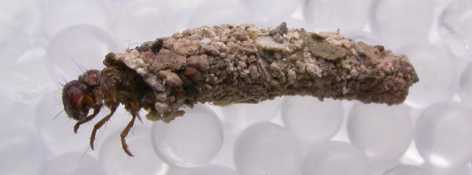
LAND CADDIS Enoicyla pusilla
Harry Green & Brett Westwood

We now have 249 records of land caddis on our data base. This includes all the published records we have found so far, together with new records collected in recent years by ourselves and others. Since our report last April Worcestershire Record we have added 26 records, many from new sites in the western half of Worcestershire. The search continues as our ultimate aim is to define the distribution of Land Caddis in England, which probably means west Worcestershire together with parts of adjoining counties of Herefordshire, Shropshire, and possibly Staffordshire and the West Midlands, depending on which county boundary versions are used. We have received several more records of land caddis entering moth traps, probably because the trap has been sited on top of them!
The detailed extent of land caddis distribution is still not fully known although all the evidence so far confirms that the species is restricted to “our” area. So far the land caddis zone seems to extend from Malvern north to a few kilometres N of Wyre Forest, and from near Bromyard east to Worcester. But much remains to be discovered! We are of course building on earlier work by David Harding (1998) and others.
Searching for land caddis in woods is very like looking for needles in haystacks. (Of the authors HG has to admit that BW is much better at it than he is - how can he see them when I can’t?!) Abundance from year to year and local distribution is very variable. The fully developed larval cases are about 8-9 mms long and 1.5-2 mms in maximum diameter. Our ability to select the “best” leaf litter for searching is improving although good-looking patches of breaking-down oak litter often lacks caddis. Admixtures of hazel and birch leaves seem to improve matters! But there continue to be surprise finds. When exploring a long narrow dingle along the Dick Brook we found active larvae crawling about on moss and litter on a very steep bank a metre or so about the stream. They had probably become too wet and were coming out to dry - the humidity of their environment is important: not soaking wet and not too dry (70-100% humidity). On another occasion we found many old cases close under coppiced alder stools. Had they climbed up in very wet conditions? In our searching we often find full-size empty cases, presumably their occupants had either died or emerged. In dry coditions it is likely that empty cases survive for a long time, perhaps several years
Land caddis emerge and mate in late summer and early autumn. The eggs hatch about a month later and the larva constructs a case mainly of sandy grains and develops through five instars. In the early stages they look like, in David Harding’s famous comment, animated All-bran. They can be abundant at this time but numbers rapidly decline, probably from predation or poor conditions. When they are bigger they are less abundant.
We have been appealing for records of land caddis since Worcestershire Record No 2 (Green 1997) and up-dating our increasing knowledge at regular intervals ever since (you can find the reports on the WBRC website, or look through your back-issues). We are grateful to those who have sent us records and hope the flow will continue. The increase in light-trapping moths at night has inadvertently added records as traps placed on top of caddis larvae have led them into the limelight! As moth trapping is set to spread and increase could moth trappers please keep a look-out for caddis and let us have the records (date, grid ref, site name, date, your name). Late summer moth traps may, we suppose, attract male land caddis (we have never seen one, or a flightless female) so small late-season caddis will be of interest.
References
GREEN G H 1997 Terrestrial (Land) caddis. Worcestershire Record 2:8.
HARDING DJL 1998 Distribution and population dynamics of a litter-dwelling
caddis, Enoicyla pusilla (Trichoptera). Applied Soil Ecology 9:203-208.
| WBRC Home | Worcs Record Listing by Issue | Worcs Record Listing by Subject |